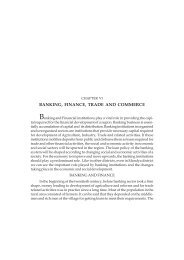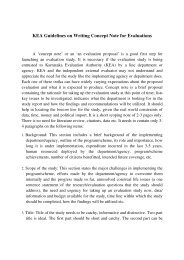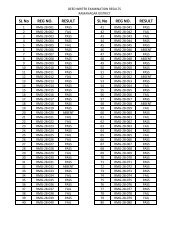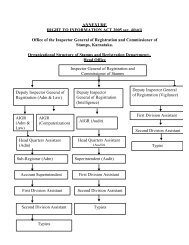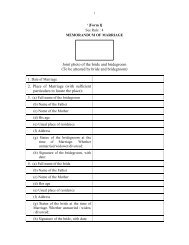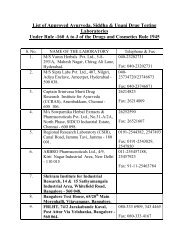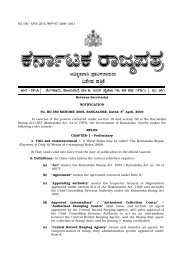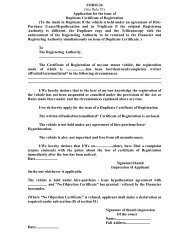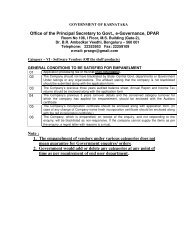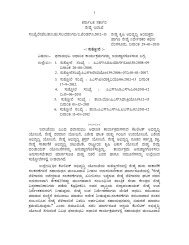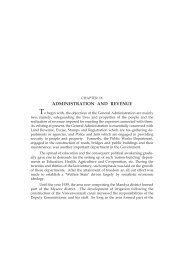Chapter XIII CULTURE - Government of Karnataka
Chapter XIII CULTURE - Government of Karnataka
Chapter XIII CULTURE - Government of Karnataka
You also want an ePaper? Increase the reach of your titles
YUMPU automatically turns print PDFs into web optimized ePapers that Google loves.
Culture 511<br />
Now, there are a dozen commercial troupes and very few temple troups<br />
maintained by devotees that <strong>of</strong>fer free performance. Yakshagana has become a<br />
fiancial success by catering to mass appeal. Many traditional elements <strong>of</strong> the<br />
Yakshagana theatre have been left in the cold. Prose has eclipsed dance. Like the<br />
cinema’s craze for novelty, new themes are gradually replacing all old popular<br />
themes based on puranic and epic ones. Vulgarity in dialogue has become the<br />
chief element in creating mass appeal. A few prominent Yakshagana troupes<br />
are from Ira, Surathkal, Saligrama, Amrutheshwara, Perdoor and Idugunji.<br />
Among old temple troupes those belonging to Mandarti, Dharmsthala, Katil<br />
and Maranakatte still thrive, but there too the trend <strong>of</strong> giving up old plays seem<br />
to gain ground. The M.G.M. College <strong>of</strong> Udupi has a Yakshagana Kendra where<br />
about a dozen students are taught traditional dance and Yakshagana methods.<br />
Two more training centres have been started at Kota and Dharmasthala in<br />
1972. The creative art form <strong>of</strong> Yakshagana with its rich costumes, dance and<br />
music has great potential but the people have yet to realise its greatness. All<br />
efforts <strong>of</strong> bringing out Yakshagana as a sophisticated art form have received<br />
scant respect and encouragement.<br />
Several artistes <strong>of</strong> Yakshagana have enriched the art by their efforts.<br />
Veerabhadra Nayak, Uppuru Narayana Bhagavata, Irodi Sadananda<br />
Hebbar, Polali Shastri, Malpe Shankaranarayana Samaga, Mowaru Kittanna<br />
Bhagavatha, Alike Ramayya Rai, Haaradi Krishna Ganiga, Haaradi Narayana<br />
Ganiga, Haaradi Rama Ganiga, Damodara Mandecha, Basava Naik, Bailpa<br />
Subbaraya, Hiriyadka Gopala Rao, Agari Srinivasa Bhagvata, Kuriya Vithala<br />
Shastri, Udyavara Madhava Acharya etc., are among the noted exponents <strong>of</strong><br />
Yakshagana from Dakshina Kannada. Keremane Shivarama Heggade (Kendra<br />
Sangeetha Nataka Academy awardee in 1971), K. Sadananda Heggade,<br />
Ganapathi Bhatta, Mudkani Narayana Heggade (Kendra Sangeetha Nataka<br />
Akademy awardee), Babu Bhatta, etc., are among the noted artistes <strong>of</strong> north<br />
Kanara District.<br />
Yakshagana is very popular even in other parts <strong>of</strong> <strong>Karnataka</strong> and it is<br />
identified as ‘Mudalapaya’. Aparala Tammanna the author <strong>of</strong> ‘Sri Krishna<br />
Parijata’, Kulagoda Tammana <strong>of</strong> Kulagodu in Belgaum district and Aliya Lingaraja<br />
<strong>of</strong> Mysore are famous Yakshagana poets. In the coastal region, Nanjaiah,<br />
Parthi Subba, Halemakki Rama, Hattiangadi Ramabhatta. Venkata Ajapura,<br />
Nityananda Avadhuta, Pandeshwara Venkata, Gerasoppe Shanthappaiah,<br />
Nagire Subrahamanya, Dhwajapurada Nagappaiah, noted Kannada poet<br />
Muddanna and Halasinahalli Narasimha Shastry are among the noted<br />
writers. There are two school <strong>of</strong> Yakshagana, called Tenkutittu (Southern) and<br />
Badagutittu (Northern). They vary in costumes, dance and other aspects from<br />
each other. Many Telugu Yakshaganas also came to be written in <strong>Karnataka</strong><br />
and among these Kempe Gowda, the feudatory <strong>of</strong> Bangalore composed ‘Ganga<br />
Gowri Vilasam’, Many more such works were composed in the Mysore Court. In<br />
Puppet Theatre too, the text and theme is <strong>of</strong> Yakshagana itself. Uppinakuduru<br />
Kogga Kamath from Dakshina Kannada is an outstanding master <strong>of</strong> this art.<br />
Mudala Paya is the variety <strong>of</strong> Yakshagana seen on the plateau, as mentioned<br />
above. An institute to foster it is functioning at Konchalli in Tiptur tq, by the



